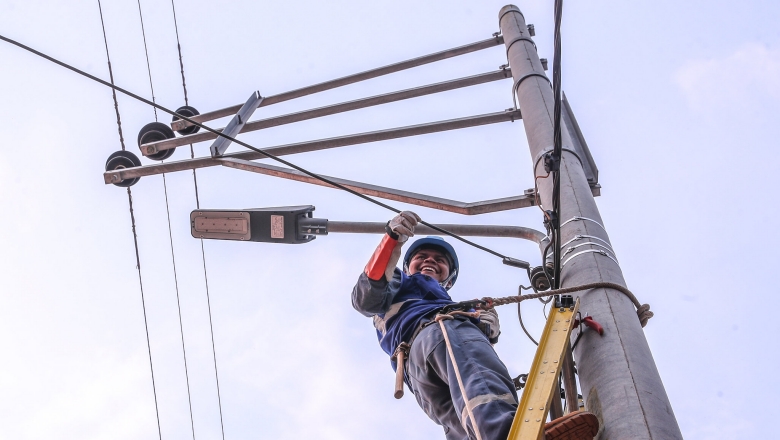Results
RE2 had three main features, initially developed for the RE1 project: (i) Electricity distribution companies made new connections and provided regulated service. (ii) Electricity connections were based on grid extension or off-grid solar home systems. (iii) Rural producers were encouraged to adopt electrical equipment.
The project’s outcomes include:
More than 36,500 households and small enterprises and public facilities, representing about 142,900 people, benefited from the new electricity connections made during the life of project. The project also generated sufficient capacity to provide new connections to an additional 26,100 people after project closure.
These connections included 11,915 solar home systems for households in remote rural areas, representing about 47,670 people. The project developed a web platform and mobile applications for lower-cost servicing and monitoring of the solar home systems.
Seven state-owned distribution companies and one private concessionaire participated in and cofinanced rural electrification subprojects in 13 regions.
A total of 4,376 small rural producers, of which 1,569 (36 percent) were women, adopted electrical equipment to increase their productivity and incomes.
A two-day forum was held under the project to share Peru’s productive uses experience with 200 representatives from producers, electricity companies, ministries, local governments, NGOs, and other participants from Argentina, Bolivia, Colombia, Haiti, and the United States.
The project held 280 meetings at which 9,700 beneficiaries received training on the efficient and safe use of electricity. The safety campaign also distributed 12,300 training kits.
Useful data for national and international evaluations of rural electrification were obtained through socioeconomic impact assessments of RE1’s rural electrification efforts and its promotion of productive uses for electricity components.
The project prepared technoeconomic and social/environmental studies for 21 small hydropower projects in Peru’s major basins.
Bank Group Contribution
The World Bank, through the International Bank for Reconstruction and Development, approved a loan of US$ 50 million, US$ 43.83 million of which was used by the project closing date. The Bank contribution financed 86.5 percent of the costs of Component 1: Rural Electrification Subprojects; 38.9 percent of Component 2: TA for Rural Electrification; and 14.1 percent of Component 3: Project Management, all excluding the value-added tax (VAT). In total, the Bank financed 76.3 percent of the cost of the project, excluding the front-end fee and VAT, and 66.8 percent of the costs including these elements.
Partners
The Bank loan was complemented by US$ 7.37 million from the government of Peru. MEM implemented the project together with seven state-owned distribution companies and one private concessionaire, which contributed US$ 6.38 million or 11 percent of the total cost (excluding VAT). Including VAT, the seven public distribution companies and one private concessionaire contributed US$ 14.42 million or 22 percent of the cost. Local NGOs were contracted by MEM to encourage small producers to adopt electrical equipment, working together with distribution companies, government programs at local, regional and national levels, and technical institutes.
Beneficiaries
 Two examples highlight specific impacts on beneficiaries from RE2. Rosa Chacón, the nursing technician of Atumpampa, La Libertad, says she can now attend to patients either day or night. Without electricity, attending patients was possible only until 5 p.m. In addition, electricity now powers a refrigerator that permits use of vaccines.
Two examples highlight specific impacts on beneficiaries from RE2. Rosa Chacón, the nursing technician of Atumpampa, La Libertad, says she can now attend to patients either day or night. Without electricity, attending patients was possible only until 5 p.m. In addition, electricity now powers a refrigerator that permits use of vaccines.
Justa Alférez (photo right), a beneficiary living in Toquela, Tacna, is one of 60 oregano producers. She recounts that she and her fellow producers used to process oregano by hand, dry it in the sun, and sell it for 3 soles per kilo. With the help of RE2, oregano producers adopted electrical equipment that increased the quality of their product, enabling them to sell it for 9 soles per kilo.
Moving Forward
The government has introduced legal measures to institutionalize the RE project model, permitting MEM to transfer resources to distribution companies for rural electrification subprojects. Tools for commercializing SHS developed under RE2 will be useful to the massive SHS program now underway as well as to the distribution companies. The General Directorate of Rural Electrification is using the value-chain approach to continue building capacity for productive uses of electricity, financed by its Rural Electrification Fund. Annual operating reports from the electricity companies now include an indicator on productive clients. Replication of the RE1/RE2 model is being considered in other countries and regions.
